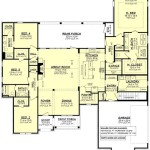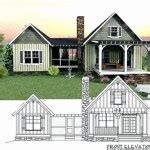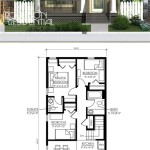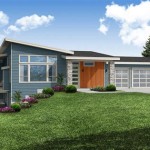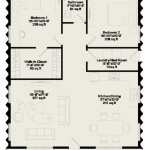Design The Perfect Floor Plan For Your Dream Home: A Comprehensive Guide
Designing the floor plan for a dream home is a pivotal step in the home-building process. It's the foundation upon which the entire living experience is built. A well-designed floor plan optimizes space, enhances functionality, and contributes significantly to the overall aesthetic appeal and value of the property. This article outlines key considerations and strategies for creating a floor plan that aligns with individual needs, lifestyle, and long-term aspirations. The process requires careful planning, consideration of various factors, and a proactive approach to anticipating future needs.
The initial stage involves defining personal priorities and requirements. This includes determining the desired size of the home, the number of bedrooms and bathrooms required, and the specific functions of different spaces. Consider the current and anticipated future needs of the occupants. A growing family, for example, will have different requirements than a retired couple. Assess lifestyle preferences: Do you frequently entertain guests? Do you work from home? Do you have hobbies that require dedicated space? These factors will significantly influence the layout and design of the floor plan.
Furthermore, it is essential to consider the property's orientation and its impact on natural light and ventilation. The optimal placement of windows and doors can maximize natural light penetration, reduce energy consumption, and enhance the overall comfort of the living spaces. Passive solar design principles should be incorporated to leverage the sun's energy for heating during winter and minimize heat gain during summer. This approach enhances energy efficiency and reduces reliance on artificial heating and cooling systems.
Understanding Space and Functionality
Effective space planning is a critical aspect of floor plan design. This involves optimizing the use of available square footage and creating a logical flow between different areas of the home. Circulation paths should be clearly defined, and potential bottlenecks should be avoided. Consider the relationship between different rooms and how they interact with each other. For instance, the kitchen should be conveniently located near the dining area and potentially adjacent to an outdoor entertaining space. Bedrooms should be separated from living areas to provide privacy and minimize noise disturbance.
The layout of the kitchen is especially important, as it is often the heart of the home. Consider different kitchen layouts, such as the U-shaped, L-shaped, galley, or island kitchen, and choose the one that best suits the available space and cooking style. Adequate counter space, storage solutions, and appliance placement are essential for creating a functional and efficient kitchen. The placement of a kitchen island can provide additional workspace, storage, and a social gathering point.
Bathrooms should be designed with functionality and comfort in mind. Consider the placement of fixtures, such as the toilet, sink, and shower or bathtub, to maximize space and create a comfortable and functional layout. Incorporate adequate storage for toiletries and linens. Consider the inclusion of a separate water closet for added privacy. Natural light and ventilation are also important considerations for bathroom design.
Living areas should be designed to accommodate different activities, such as relaxation, entertainment, and social gatherings. Consider the placement of furniture, the size and shape of the room, and the flow of traffic. The inclusion of large windows or sliding doors can connect the living area to the outdoors, creating a sense of spaciousness and bringing in natural light. Consider incorporating a fireplace as a focal point for the living space.
Bedrooms should be designed as personal retreats, providing a comfortable and private space for rest and relaxation. Consider the size and layout of the room, the placement of windows, and the inclusion of a walk-in closet. Adequate storage is essential for keeping the bedroom organized and clutter-free. The orientation of the bedroom should be considered to maximize natural light and minimize noise disturbance.
Considering Accessibility and Aging in Place
Incorporating universal design principles into the floor plan ensures that the home is accessible and adaptable to the needs of occupants of all ages and abilities. This is especially important for aging in place, allowing individuals to remain in their homes comfortably and safely as they grow older. Wide doorways and hallways, level thresholds, and grab bars in bathrooms are some of the key features of universal design.
Single-story homes or homes with elevators are ideal for aging in place, as they eliminate the need to navigate stairs. If stairs are unavoidable, consider incorporating features such as handrails on both sides of the staircase and adequate lighting. Ramps can be used to provide access to entrances and exits for individuals who use wheelchairs or other mobility devices.
Bathrooms should be designed with accessible features, such as roll-in showers, grab bars near the toilet and shower, and adjustable-height sinks. Kitchens should also be designed with accessibility in mind, with adjustable-height countertops and appliances. This allows individuals of different heights and abilities to use the kitchen comfortably and safely.
Lighting is an important consideration for accessibility. Ensure that all areas of the home are well-lit, with a combination of natural and artificial light. Use task lighting to illuminate specific areas, such as kitchen countertops and reading nooks. Avoid glare and shadows, which can make it difficult for individuals with vision impairments to navigate the home.
Flooring should be slip-resistant to prevent falls. Avoid using slippery surfaces, such as polished marble or tile, in areas where falls are more likely to occur, such as bathrooms and kitchens. Consider using textured flooring or non-slip mats to improve traction.
Incorporating Sustainability and Energy Efficiency
Designing a sustainable and energy-efficient home involves incorporating features that minimize environmental impact and reduce energy consumption. This includes selecting energy-efficient appliances, using sustainable building materials, and incorporating renewable energy sources.
Consider the orientation of the home to maximize solar gain during winter and minimize heat gain during summer. Proper insulation is essential for reducing energy consumption. Use high-performance windows and doors to prevent heat loss and gain. Seal air leaks to prevent drafts and improve energy efficiency.
Incorporate renewable energy sources, such as solar panels, to generate electricity and reduce reliance on fossil fuels. Consider using a rainwater harvesting system to collect rainwater for irrigation and other non-potable uses. Install low-flow toilets and showerheads to conserve water.
Select sustainable building materials, such as bamboo, reclaimed wood, and recycled content materials. These materials have a lower environmental impact than traditional building materials. Use low-VOC paints and finishes to improve indoor air quality. Ensure proper ventilation to remove pollutants and maintain a healthy indoor environment.
Landscape the property with native plants to reduce water consumption and provide habitat for wildlife. Use permeable paving materials to allow rainwater to infiltrate the ground and reduce runoff. Consider incorporating a green roof to reduce heat gain and improve air quality.
Consider the long-term costs and benefits of different design choices. Investing in energy-efficient and sustainable features may have a higher upfront cost, but it can result in significant savings over the long term. A well-designed floor plan can also increase the resale value of the home.
The process of designing the perfect floor plan for a dream home is multifaceted and requires careful consideration of various factors. By prioritizing personal needs, optimizing space and functionality, incorporating accessibility features, and embracing sustainability, homeowners can create a living space that is both comfortable and environmentally responsible. Consultation with architects, interior designers, and building professionals can provide invaluable insights and guidance throughout the design process.

What Makes A Good Floor Plan

Tips For Selecting The Right Floor Plan Your Home Sater Design Collection

How To Choose The Perfect Floor Plan G J Gardner Homes

5 Tips To Build Your Dream Home And Stay On Budget Dfd House Plans Blog

How To Design A House From Sketch Reality

My Dream Home Free Online Design 3d Floor Plans By Planner 5d

Gorgeous Guest House Floor Plans Interior Design Ideas Alisha Taylor

Discover The Best Duplex Designs Floor Plans For Your Dream Home Beautiful Homes

Sims 4 House Layouts And Floor Plans To Build Your Dream Home Mom S Got The Stuff

Dream Home Top 5 Ideas To Create Your Perfect Space Sky
Related Posts


